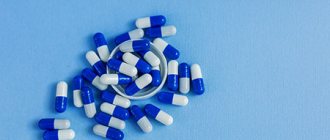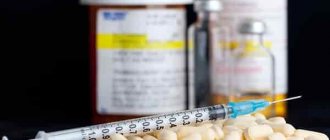Anonymously
Around the clock
Attention! The material contains information about substances, the use of which can cause serious harm to your health!
Article prepared by an expert
Egorova Yulia Viktorovna
Psychologist, diagnostician, author of rehabilitation programs for addicts. Member of the Association of Cognitive Behavioral Psychotherapy. More than 7 years of experience working with addicts and their families.
Read in the article:
- Why is Fluoxetine considered a drug?
- Why is the drug dangerous?
- Consequences of non-medical use
- Signs of overdose
- Addiction treatment
Human life in today's society is filled with stress. He worries about his job, loans, bills. About the health of family and friends, your own health, about relationships in the family and with people you know. All these factors negatively affect the emotional state.
To support and normalize psychological health, people are prescribed antidepressants. Fluoxetine is the active ingredient in the widely known and frequently used drug Prozac in America. Read our article about whether it is safe to take such medications and why they cause addiction.
Composition and dosage form of the drug
The medication contains fluoxetine hydrochloride, a selective antipsychotic that is effective in emotionally depressed states. The drug is available in the form of tablets for oral administration: yellowish in color, film-coated. Active substance content in 1 piece: 20 mg. As auxiliary compounds, Fluoxetine contains starch, talc, silicon dioxide, magnesium stearate, sucrose, and wax. The drug is sold in packages of 10 or 20 tablets, packaged in cell plates.
Manifestations of narcotic effects
Taking the medicine in combination with a number of drugs enhances the drug effects of the latter. This property is the main reason why people suffering from addiction begin to use this antidepressant. In some cases, even isolated use of a drug can give patients narcotic sensations. This phenomenon becomes the beginning of the formation of addiction. Prozac can cause:
- euphoria and mental comfort;
- psychostimulation;
- exacerbation of all types of sensitivity;
- a surge of mental performance and physical strength.
Mechanism of action of Fluoxetine
The drug prevents the reuptake of serotonin, helping to increase its concentration. As a result, after taking it, mood normalizes, apathy disappears, and performance increases. Fluoxetine has a slight effect on the uptake of dopamine and norepinephrine, having a selective antidepressant and pronounced stimulating effect.
The drug does not cause mental retardation, drowsiness, and does not reduce the speed of motor reactions and intellectual abilities. Fluoxetine helps get rid of dysphoria, fear, indecision, emotional instability, tension, absent-mindedness, and helps to better concentrate. The product has the property of reducing appetite until it is completely absent.
Fluoxetine is well absorbed through the mucous membranes, has high bioavailability, and binds to blood proteins. The presence or absence of food does not affect the speed of action of the medicine. The active substance is metabolized in liver tissue. The elimination period of the drug is long - up to 72 hours, during which their therapeutic effect persists. The antidepressant effect increases as the course continues. Lasting results are observed from 3-4 weeks of use and develop over several months.
Exceeding recommended doses or incorrect use of the drug can lead to withdrawal effects: increased depression, emotional swings.
Fluoxetine
Sui ideal risk:
With depression, there is a possibility of suicide attempts, which may persist until stable remission occurs. As with other drugs of similar pharmacological action (antidepressants), isolated cases of suicidal thoughts and eating behavior have been described during therapy with fluoxetip or shortly after its end; careful monitoring of patients at risk is necessary. Clinicians should encourage patients to promptly report any distressing thoughts or feelings.
Although the effect of fluoxetine on the occurrence of such cases has not been established, data from pooled studies of the use of antidepressants in mental disorders revealed an increased risk of suicidal ideation and/or suicidal behavior in young patients (<25 years of age) compared with placebo.
Drug therapy for high-risk patients should be under close medical supervision. Clinicians should encourage patients of all ages to report any unpleasant thoughts and feelings that arise at any time during therapy.
In studies of adult patients with major depressive disorder, the following risk factors for suicide were identified in both groups taking placebo and fluoxetine.
Before treatment:
more severe depression; presence of thoughts about death.
During treatment:
worsening depression;
development of insomnia.
During treatment with fluoxetine, a risk factor was the development of severe psychomotor agitation (for example, agitation, akathisia, panic).
The presence or occurrence of these conditions before or during therapy is a reason to strengthen clinical monitoring or adjust the treatment.
Cardiovascular effects:
Due to the possible risk of QT prolongation associated with fluoxetine. Exetine should be used with caution in patients with congenital long QT syndrome. acquired long QT interval syndrome (for example, with alternating use of fluoxetine with drugs that prolong the QT interval), if there is a history of indications of an increase in the duration of the QT interval in the patient’s relatives. in other clinical conditions predisposing to the development of arrhythmia (eg, hypokalemia or hypomagnesemia) or with increased exposure to fluoxetine (eg, decreased liver function).
Skin rash:
Skin rash, anaphylactic reactions and progressive systemic disorders, sometimes serious involving the skin, kidneys, liver and lungs, have been reported in patients taking fluoxetine. If skin rash or other possible allergic reactions occur, the etiology of which cannot be determined, fluoxetine should be discontinued.
Electroconvulsive therapy (ECT):
There have been rare reports of increased seizure duration in patients taking fluoxetine and receiving ECT. Caution is therefore advised.
Epileptic seizures:
As with other antidepressants, fluoxetine should be used with caution in patients with a history of seizures.
Mani and: A
Antidepressants should be used with caution in patients with a history of major headaches/hypomania. Fluoxetine, like any other antidepressant, should be stopped if the patient is in a manic state.
Akathisia/psychomotor restlessness:
The use of fluoxetine leads to the development of akathisia, which is manifested by subjectively unpleasant sensations or restlessness, the need for constant movement, often without the ability to sit or stand still. Most often, such phenomena are observed during the first few weeks of treatment. In patients who experience these symptoms, increasing the dose of fluoxetine is not advisable.
Tamoxifen:
Fluoxetine, as a strong inhibitor of the CYP2D6 isoenzyme, can lead to a decrease in the concentration of endoxifene, one of the most important active metabolites of tamoxifsne. Therefore, fluoxetine should be avoided during tamoxifen therapy.
Weight loss:
When using fluoxetine, patients may experience weight loss, however, it is proportional to the initial average body weight.
Hypotatremia:
There have been cases of hyponatremia (in some cases, the level of sodium in the blood plasma was less than 110 mmol/l). Mostly, such cases were observed in elderly patients and in patients receiving diuretics due to a decrease in circulating blood volume.
Glycemic control:
In patients with diabetes mellitus, hypoglycemia was observed during treatment with fluoxetine, and hyperglycemia developed after discontinuation of the drug. At the beginning or after completion of treatment with fluoxetine, dose adjustments of insulin and/or oral hypoglycemic drugs may be required.
Liver/renal failure:
Fluoxetine undergoes extensive metabolism in the liver and is excreted by the kidneys. For patients with severe liver dysfunction, it is recommended to prescribe lower concentrations of fluoxetine, or prescribe the drug every other day. When taking fluoxetine at a dose of 20 mg/day for two months in patients with severely impaired renal function (creatinine clearance < 10 ml/min) requiring hemodialysis, there were no differences in the concentrations of fluoxetine and norfluoxetine in the blood plasma from healthy volunteers with normal kidney function.
Midriaz:
Mydriasis has been reported in association with fluoxetine. Caution should be exercised when prescribing fluoxetine to patients with elevated intraocular pressure or to patients at risk of developing acute angle-closure glaucoma.
St. John's wort:
As with other SSRIs, a pharmacodynamic interaction may develop between fluoxetine and products containing St. John's wort, which may lead to increased undesirable effects.
Withdrawal symptoms:
Withdrawal symptoms are common when fluoxetine therapy is stopped, especially when the drug is discontinued abruptly. In clinical studies, approximately 60% of patients developed various side effects when therapy was discontinued, both in the fluoxetine group and in the placebo group. In the fluoxetine group, 17% of these events were severe, in rpyi ps placebo - 12%.
The risk of developing withdrawal symptoms depends on several factors, including the duration of the therapy dose and the rate of dose reduction. The most commonly reported symptoms were dizziness, sensory disturbances (including paresthesia), sleep disturbances (including insomnia and deep sleep), asthenia, anxiety or agitation, nausea and/or vomiting, tremor and headache. These episodes were usually mild or moderate in severity, but in some patients they could be more severe. In most cases, these phenomena resolve on their own within two weeks, but sometimes they can last longer (2-3 months or more). In this regard, discontinuation of fluoxetine therapy should be carried out gradually over one or two weeks, depending on the patient's condition.
In rare cases, the development of serotonin syndrome or neuroleptic malignant syndrome (muscle rigidity, hyperthermia, extrapyramidal neurological disorders and catatonic manifestations) has been reported associated with fluoxetine, especially when used together with other neuroleptic drugs (including those containing L-tryptophan) and /or neuroleptics. Because these syndromes can lead to a life-threatening condition, fluoxetine therapy should be discontinued if a combination of symptoms: hyperthermia, rigidity, myoclonus, autonomic nervous system disorder with development of fluctuating vital signs, mental status changes including confusion, irritability, extreme agitation with possible development of delirium and coma, and prescribe appropriate therapy.
Increased bleeding:
SSRIs and SNRIs, including fluoxetine, may increase bleeding susceptibility, including in the gastrointestinal tract. In this regard, it is recommended to exercise caution when prescribing fluoxetine to patients concomitantly receiving anticoagulants and/or drugs that can alter the properties of platelets (for example, non-steroidal anti-inflammatory drugs, acetylsalicylic acid), or to patients who already have increased bleeding.
All patients taking antidepressants for any indication should be closely monitored for signs of clinical worsening, suicidal ideation, and unusual behavioral changes, especially during the first months of therapy or during dosage changes (increases or decreases).
The following symptoms have been observed in adults and children taking antidepressants for the treatment of major depressive disorder, as well as for other mental and non-mental disorders: anxiety, agitation, panic attacks, insomnia, irritability, hostility, aggressiveness, impulsivity, akathisia (restlessness), hypomania , mania.
Although a causal relationship between the onset of such symptoms and worsening depression and/or the emergence of suicidal ideation has not been established, there is concern that such symptoms may be precursors to the onset of suicidal ideation.
When should you take Fluoxetine?
The drug is prescribed to correct the mental state and eliminate symptoms of depression. Fluoxetine is effective for the following disorders:
- gloomy, depressed mood;
- lack of motivation;
- apathy caused by severe stress;
- obsessive-compulsive disorder;
- painful anxiety.
The drug is also indicated in the case of bulimia, a neurotic eating disorder manifested by gluttony. Improved mood and decreased appetite as a result of taking it help to switch attention from food to other things.
Addiction treatment
Getting rid of a painful addiction to Fluoxetine may be required for patients who exceed the dosage of the drug, as well as for those who used the drug to enhance the effects of drugs or alcohol. In the latter case, the patient must undergo a full course of treatment for alcohol or drug addiction.
If your loved ones need help in treating drug addiction, then sign up for a free consultation by calling the hotline of the Zdravnitsa professional treatment and rehabilitation center: 8-800-200-27-23 . Our specialists will select an effective treatment plan and accompany you throughout the course. We guarantee results if all our recommendations are followed.
Similar articles:
Spice withdrawal
Lyrica - a drug or a medicine?
Tramadol: what is it, the effect and consequences of use
How drug addicts use the drug “Lyrica”
10 tips from a psychologist on how to get rid of gambling addiction
Contraindications to taking Fluoxetine
It is prohibited to use an antidepressant for the following disorders:
- history of seizures or epilepsy;
- prostate adenoma;
- delays in diuresis;
- glaucoma;
- intracranial pressure disorders;
- tendency to suicide attempts;
- agitated depression;
- severe kidney or liver failure.
It is also necessary to avoid using Fluoxetine if you are hypersensitive to one or more components of the drug.
Signs of overdose
If you do not follow the dosage prescribed by your doctor, an overdose with the following symptoms is possible:
- nausea and vomiting, stomach pain;
- limb spasms;
- feeling of fear, anxiety;
- epilepsy attack.
In case of overdose of the drug, gastric lavage and sorbents are prescribed. If seizures or epilepsy occur, the doctor will prescribe appropriate therapy.
Side effects
During treatment with the drug, various reactions may develop in the vascular, nervous and digestive systems:
- headache;
- insomnia;
- increased sweating;
- tremor;
- irritability;
- violation of thermoregulation;
- panic attacks;
- tachycardia;
- hyperreflexia;
- spasms of muscles and internal organs;
- change in taste, dry mouth, nausea.
People prone to hypertension may experience increased blood pressure and associated negative symptoms.
Some Notes on the Drug Side of Prozac
Narcologists have different opinions about both the benefits and harms of this pharmaceutical drug. Some believe that the risk of addiction and complications from it is high, others provide evidence in favor of the fact that Fluoxetine is harmless. All over the world, despite the fact that this medicine belongs to “veterans”, millions of prescriptions are still written for its purchase. Prozac has attracted the attention of various specialists due to its connection with suicide attempts described in sources not related to official medicine. According to these statistics, Fluoxetine has caused crimes and a large number of complaints about its side effects. Therefore, before taking this medicine, be sure to consult your doctor.
Find out the cost of addiction treatment
How to take Fluoxetine
The tablets are taken in the dose prescribed by the doctor, washed down with water. It is not necessary to associate the medicine with periods of eating. It is preferable to take Fluoxetine in the morning, as it has a pronounced stimulating effect.
The treatment regimen depends on the identified disorders. General recommendations:
- 1 tablet once a day: to eliminate symptoms of apathy and depression;
- 1 tablet 2-3 times a day: for the treatment of bulimia.
In some cases, the dosage may be increased to 5-6 or 8 tablets per day. Their intake is divided into 3-4 times.
The course of treatment for acute stress is 3–4 weeks. For prolonged depression, it is necessary to take Fluoxetine for at least 3-4 months, sometimes up to six months. It is necessary to discontinue therapy according to a specific regimen, gradually reducing the dose. Abrupt withdrawal of the drug can cause a relapse of negative conditions.
Why is the drug dangerous?
Side effects occur if a person does not follow the dosage prescribed by the doctor. Over time, a person becomes addicted, and then develops a number of side effects that destroy the nervous system.
It is almost impossible to get rid of such addiction on your own and requires long-term therapy and the help of doctors, narcologists and psychologists.
Efficacy of the drug
Considering the existing risks of treatment with Fluoxetine, a number of studies have been conducted to evaluate the therapeutic effectiveness of this drug and the validity of its prescription. They showed that it has a good ability to relieve anxiety and depression. Therefore, Fluoxetine is widely used in the complex treatment of many psychoneurological disorders. However, there is also conflicting data indicating the high danger of the drug and low effectiveness, comparable to a placebo (dummy). Therefore, the drug should be taken seriously and not taken without a doctor’s recommendation.
Fluoxetine drug interactions
Concomitant use with MAO inhibitors is contraindicated. After stopping taking MAO inhibitors, the use of fluoxetine is possible no earlier than 14 days. Before starting the use of MAO inhibitors, at least 5 weeks must pass after taking fluoxetine. It is recommended to be careful in cases of combined use of fluoxetine and other psychotropic drugs: lithium preparations (both increasing and decreasing the concentration of the latter in the blood plasma are possible), tricyclic antidepressants, tryptophan preparations.
Scandal around Fluoxetine (Prozac)
Recently, the press discussed the possibility of prescribing fluoxetine in psychiatry. In Europe, a scandal erupted in connection with this, which resulted in a ban on treatment with this drug and withdrawal from the pharmacy chain. In the Russian Federation, similar actions were not followed - it remained in the Register of Medicines Approved for Medical Use.
To avoid the negative consequences of treatment with Fluoxetine, it is necessary to use it only on the recommendation of a doctor.
Therefore, in modern conditions, this antidepressant can only be purchased in the pharmacy chain with a prescription. But there is also the other side of the coin - online pharmacies prohibited by law. In them, the drug is sold illegally - over the counter. It should be remembered that if you purchase the drug without consulting a doctor, the risk of developing fluoxetine addiction is very high. It manifests itself with serious symptoms that a person cannot cope with on his own. An overdose can result in cardiac arrest and death.







